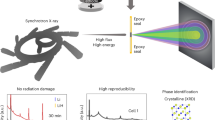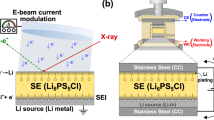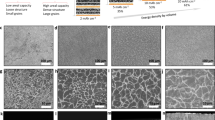Abstract
A comprehensive understanding of the solid–electrolyte interphase (SEI) composition is crucial to developing high-energy batteries based on lithium metal anodes. A particularly contentious issue concerns the presence of LiH in the SEI. Here we report on the use of synchrotron-based X-ray diffraction and pair distribution function analysis to identify and differentiate two elusive components, LiH and LiF, in the SEI of lithium metal anodes. LiH is identified as a component of the SEI in high abundance, and the possibility of its misidentification as LiF in the literature is discussed. LiF in the SEI is found to have different structural features from LiF in the bulk phase, including a larger lattice parameter and a smaller grain size (<3 nm). These characteristics favour Li+ transport and explain why an ionic insulator, like LiF, has been found to be a favoured component for the SEI. Finally, pair distribution function analysis reveals key amorphous components in the SEI.
This is a preview of subscription content, access via your institution
Access options
Access Nature and 54 other Nature Portfolio journals
Get Nature+, our best-value online-access subscription
$29.99 / 30 days
cancel any time
Subscribe to this journal
Receive 12 print issues and online access
$259.00 per year
only $21.58 per issue
Buy this article
- Purchase on Springer Link
- Instant access to full article PDF
Prices may be subject to local taxes which are calculated during checkout



Similar content being viewed by others
Data availability
All relevant data in the article are available from the corresponding author upon reasonable request.
References
Whittingham, M. S. Ultimate limits to intercalation reactions for lithium batteries. Chem. Rev. 114, 11414–11443 (2014).
Liu, J. et al. Pathways for practical high-energy long-cycling lithium metal batteries. Nat. Energy 4, 180–186 (2019).
Lin, D., Liu, Y. & Cui, Y. Reviving the lithium metal anode for high-energy batteries. Nat. Nanotechnol. 12, 194–206 (2017).
Aurbach, D. & Weissman, I. On the possibility of LiH formation on Li surfaces in wet electrolyte solutions. Electrochem. Commun. 1, 324–331 (1999).
Xiao, J. How lithium dendrites form in liquid batteries. Science 366, 426–427 (2019).
Liu, B., Zhang, J.-G. & Xu, W. Advancing lithium metal batteries. Joule 2, 833–845 (2018).
Zachman, M. J., Tu, Z., Choudhury, S., Archer, L. A. & Kourkoutis, L. F. Cryo-STEM mapping of solid–liquid interfaces and dendrites in lithium-metal batteries. Nature 560, 345–349 (2018).
Fang, C. et al. Quantifying inactive lithium in lithium metal batteries. Nature 572, 511–515 (2019).
Cheng, X.-B. et al. A review of solid electrolyte interphases on lithium metal anode. Adv. Sci. 3, 1500213 (2016).
Borodin, O. et al. Uncharted waters: super-concentrated electrolytes. Joule 4, 69–100 (2020).
Wang, X. et al. New insights on the structure of electrochemically deposited lithium metal and its solid electrolyte interphases via cryogenic TEM. Nano Lett. 17, 7606–7612 (2017).
Li, Y. et al. Atomic structure of sensitive battery materials and interfaces revealed by cryo-electron microscopy. Science 358, 506–510 (2017).
Wang, X. et al. Cryogenic electron microscopy for characterizing and diagnosing batteries. Joule 2, 2225–2234 (2018).
Wood, K. N. et al. Operando X-ray photoelectron spectroscopy of solid electrolyte interphase formation and evolution in Li2S-P2S5 solid-state electrolytes. Nat. Commun. 9, 2490 (2018).
Nandasiri, M. I. et al. In situ chemical imaging of solid-electrolyte interphase layer evolution in Li−S batteries. Chem. Mater. 29, 4728–4737 (2017).
Wan, C. et al. Multinuclear NMR study of the solid electrolyte interface formed in lithium metal batteries. ACS Appl. Mater. Interfaces 9, 14741–14748 (2017).
Wang, L. et al. Identifying the components of the solid–electrolyte interphase in Li-ion batteries. Nat. Chem. 11, 789–796 (2019).
Ota, H., Sakata, Y., Wang, X., Sasahara, J. & Yasukawa, E. Characterization of lithium electrode in lithium imides/ethylene carbonate and cyclic ether electrolytes: II. surface chemistry. J. Electrochem. Soc. 151, A437–A446 (2004).
Shen, C. et al. Direct observation of the growth of lithium dendrites on graphite anodes by operando EC-AFM. Small Methods 2, 1700298 (2018).
Liu, T. et al. In situ quantification of interphasial chemistry in Li-ion battery. Nat. Nanotechnol. 14, 50–56 (2019).
Sun, Y. & Ren, Y. In situ synchrotron X-ray techniques for real-time probing of colloidal nanoparticle synthesis. Part. Part. Syst. Charact. 30, 399–419 (2013).
David, W. I. F. et al. A mechanism for non-stoichiometry in the lithium amide/lithium imide hydrogen storage reaction. J. Am. Chem. Soc. 129, 1594–1601 (2007).
Zimmerman, W. B. Lattice-constant dependence on isotopic composition in the 7Li (H, D) system. Phys. Rev. B 5, 4704–4707 (1972).
Tyutyunnik, O. I. et al. Lithium hydride single crystal growth by bridgman-stockbarger method using ultrasound. J. Cryst. Growth 68, 741–746 (1984).
Srivastava, K.-K. & Merchant, H. D. Thermal expansion of alkali halides above 300°K. J. Phys. Chem. Solids 34, 2069–2073 (1973).
Ben Yahia, H. et al. Synthesis and characterization of the crystal structure, the magnetic and the electrochemical properties of the new fluorophosphate LiNaFe[PO4]F. Dalton Trans. 41, 11692–11699 (2012).
Dong, H. et al. Compression of lithium fluoride to 92 GPa. High Press. Res. 34, 39–48 (2014).
Fukuhara, M. Lattice expansion of nanoscale compound particles. Phys. Lett. A 313, 427–430 (2003).
Ahmad, M. I. & Bhattacharya, S. S. Size effect on the lattice parameters of nanocrystalline anatase. Appl. Phys. Lett. 95, 191906 (2009).
Tsunekawa, S., Ishikawa, K., Li, Z. Q., Kawazoe, Y. & Kasuya, A. Origin of anomalous lattice expansion in oxide nanoparticles. Phys. Rev. Lett. 85, 3440–3443 (2000).
Szczȩśniak, M. M. & Ratajczak, H. Ab initio calculations on the lithium fluoride–ethylene complex. J. Chem. Phys. 67, 5400–5401 (1977).
Hahn, H. & Strick, G. Zur Mischkristallbildung zwischen Lithiumfluorid und Lithiumhydrid. Z. Anorg. Allg. Chem. 372, 248–251 (1970).
Varotsos, P. A. & Mourikis, S. Difference in conductivity between LiD and LiH crystals. Phys. Rev. B 10, 5220–5224 (1974).
Niu, C. et al. High-energy lithium metal pouch cells with limited anode swelling and long stable cycles. Nat. Energy 4, 551–559 (2019).
Neuhaus, J., von Harbou, E. & Hasse, H. Physico-chemical properties of solutions of lithium bis(fluorosulfonyl)imide (LiFSI) in dimethyl carbonate, ethylene carbonate, and propylene carbonate. J. Power Sources 394, 148–159 (2018).
Hammersley, A. P., Svensson, S. O., Hanfland, M., Fitch, A. N. & Hausermann, D. Two-dimensional detector software: from real detector to idealised image or two-theta scan. High Press. Res. 14, 235–248 (2006).
Qiu, X., Thompson, J. W. & Billinge, S. J. L. PDFgetX2: a GUI-driven program to obtain the pair distribution function from X-ray powder diffraction data. J. Appl. Crystallogr. 37, 678 (2004).
Blöchl, P. E. Projector augmented-wave method. Phys. Rev. B 50, 17953–17979 (1994).
Kresse, G. & Furthmüller, J. Efficiency of ab-initio total energy calculations for metals and semiconductors using a plane-wave basis set. Comput. Mater. Sci. 6, 15–50 (1996).
Perdew, J. P., Burke, K. & Ernzerhof, M. Generalized gradient approximation made simple. Phys. Rev. Lett. 77, 3865–3868 (1996).
Acknowledgements
The work done at Brookhaven National Laboratory was supported by the Assistant Secretary for Energy Efficiency and Renewable Energy, Vehicle Technology Office of the US Department of Energy (DOE) through the Advanced Battery Materials Research (BMR) Program, including Battery500 Consortium under contract no. DE-SC0012704. The work done at Pacific Northwest National Laboratory was supported by the Assistant Secretary for Energy Efficiency and Renewable Energy, Office of Vehicle Technologies of the US DOE through the Advanced Battery Materials Research (BMR) Program (Battery500 Consortium) under contract no. DE-AC02-05CH11231. The work at the Army Research Laboratory was performed under JCESR, an Energy Research Hub funded by Basic Energy Sciences, US DOE. This research used beamline 28-ID-2 of the National Synchrotron Light Source II, a US DOE Office of Science user facility operated for the DOE Office of Science by Brookhaven National Laboratory under contract no. DE-SC0012704.
Author information
Authors and Affiliations
Contributions
J.X., E.H. and X.-Q.Y. proposed the research. J.X., J.L. and X.-Q.Y. organized and guided scientific discussions. H.L. and X.C. performed electrochemical characterization and SEI sample preparation. Z.S., X.W., O.B., S.G., C.W., X.F., S.-M.B., R.L. and E. H. performed XRD and PDF measurements and carried out the analysis. Z.S., J.X., E.H., K.X. and X.-Q.Y. prepared the manuscript with critical input from all other authors.
Corresponding authors
Ethics declarations
Competing interests
The authors declare no competing interests.
Additional information
Peer review information Nature Nanotechnology thanks Marcella Bini, Donal Finegan and the other, anonymous, reviewer(s) for their contribution to the peer review of this work.
Publisher’s note Springer Nature remains neutral with regard to jurisdictional claims in published maps and institutional affiliations.
Supplementary information
Supplementary Information
Supplementary Figs. 1–5, Tables 1–14, note and refs. 1 and 2.
Rights and permissions
About this article
Cite this article
Shadike, Z., Lee, H., Borodin, O. et al. Identification of LiH and nanocrystalline LiF in the solid–electrolyte interphase of lithium metal anodes. Nat. Nanotechnol. 16, 549–554 (2021). https://doi.org/10.1038/s41565-020-00845-5
Received:
Accepted:
Published:
Issue Date:
DOI: https://doi.org/10.1038/s41565-020-00845-5
This article is cited by
-
Gas induced formation of inactive Li in rechargeable lithium metal batteries
Nature Communications (2023)
-
Production of high-energy 6-Ah-level Li | |LiNi0.83Co0.11Mn0.06O2 multi-layer pouch cells via negative electrode protective layer coating strategy
Nature Communications (2023)
-
Designing electrolytes and interphases for high-energy lithium batteries
Nature Reviews Chemistry (2023)
-
An inorganic-rich but LiF-free interphase for fast charging and long cycle life lithium metal batteries
Nature Communications (2023)
-
Unravelling the convoluted and dynamic interphasial mechanisms on Li metal anodes
Nature Nanotechnology (2023)



